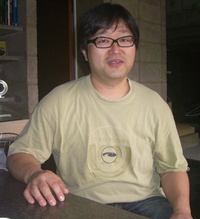その2を読む >>
プロへの道をまっしぐら=とんとん拍子で出世街道へ
重厚な作品集を繰りながら、「少しずつ細部を取り除き、骨組みだけを描き始めた。事物のエッセンスだけを描いているのが面白いところ」と作品の魅力を語るリカルドさんの言葉には、母への敬意がにじんでいる。
年を経るごとに絵の細部がこそげ落ちていき、わずか数年で抽象画に移行している。同時に、初期の作品に多い暗い色合いは影を潜め、明るい彩りが取って変わる。例えば彼女の多くの作品に表れる紅だ。まるで心の底に沈んでいた “日本的なもの” を吐き出すかのよう―というのは勝手な印象かもしれないが、心から自由を謳歌する彼女の喜びの表現なのは、確かな気がする。
* * *
「画家として売れるには、相当の苦労があっただろう」と思いきや、富江さんと話していても、そんな苦労話は一向に出てこない。
古くから彼女と付き合いのある画家・故間部学氏の妻よしのさん(83、新潟)に聞いても「苦労したのは見たことがない。スランプで苦しんでいるところ? そんな様子がにじんでたことはないですね」という具合だ。
間部家がリンス市から聖市に引っ越した67年、大竹富江の名は大分知られていたようで、よしのさんは「富江さんは私と年もうんと違うし、体格もいいし、雲の上の人みたいだった。ブラジル人とのお付き合いもぜんぜん怖気ないし、前向きに何でもやり遂げようという意志が強い方」と語る。
富江さん本人は「60歳になってから売れ出した」と言うが、彼女の “出世” に関しては、やはり「とんとん拍子で成功した」というのがリカルドさんやアシスタントの吉沢太さんの意見だ。絵を始めて6、7年後には個展を開き、徐々に新聞に取り上げられるようになっていた。
初めはモッカ区に住んでいたので、同区に住むイタリア系伯人らが彼女を展覧会に誘ったりもしていたようだ。また、ブラジリア、リオなど大都市であった大展覧会にも、こまめに出展していた。でも、「まだ大竹富江の名前は誰もしらない時代なのに、いっぱい来てくれて。ノン・セイ・ポルケ」という本人の天真爛漫で無頓着な口ぶりからは、自ら必死に売り込みをした様子は感じられない。とにかく展覧会という展覧会に出品し、力試しをしたといった風だ。
アシスタントの吉沢太さん(49、埼玉)によれば、「富江さんはずっと一線でやってきただけあって、意志の強さがすごい。仕事にはすごく厳しくて、とことん納得するまでやる人」。
やはり才能と地道な努力が100歳の現役芸術家を生んだのだろうか。
しかしながら、彼女の名をさらに伯国社会に知らしめたのは息子たちの力が大きいと考える人は多い。吉沢さんは、大竹親子を「三本の矢」とうまく表現している。
オスカー・ニーマイヤーとの合同展覧会の機会には、絵が専門でありながら数々の巨大オブジェの制作にも着手した。誰かの強力な力添えがあったはずだが、リカルドさんは「母が有名になったのは自分たちの力どころか、僕たちが母の名声を利用した方」と少し冗談めかして否定する。
「パトロン?そんなものは、ほしくてもいなかった。サロンやビエナーレがあるたびに地道に絵を出品していたこと、そして、何よりもいい芸術家で勤勉だったことに尽きる。日系社会の中にとどまらなかったことも、不可欠の要因だ」と付け加えた。
日系社会では異端児か=神経太 “大竹時間” 貫く
大竹富江は日系社会の異端児だ。ある部分で肩を寄せ合うように徒党を組んで生きた、多くの戦前移民とは対照的な存在だ。彼女を知る人は一貫して、「ブラジル社会で生きていた人」と口をそろえる。
日系画壇「聖美会」(1935年設立)にも入会していたが、それほど深いかかわりはなかったとされる。リカルドさんはこの会を「移民の共同体でこういうグループを作ったところはない。日本人の芸術への意識の現われ」と高く評価している。
会員だった画家・若林和男さん(82、神戸)は、「会員はプロであっても、『コロニアに錦を飾ろう』と考えるような人が多かったと思う」と言う。新人を温かく受け入れる一方、閉鎖的なコロニアの気質を擁しており、伯社会に進んで入っていこうとはしない聖美会と、戦後移民の考えとは相容れないものがあったようだ。
「大竹さんは、戦後移住した日系美術家に考えが近かったと思う。『コロニアがあるからブラジルに来たんじゃない』と考える戦後の人たちの目的の先には、ブラジル美術界があった」と若林さん。富江さんはその先陣を切った一人だったのだろう。
50年代、2度サンパウロ・ビエンナーレに出展した津高和一さんから富江さんと間部学さんの紹介状を手に入れ、61年に妻と渡伯した。作家生活が始まると同時にブラジル社会に飛び込んだ富江さんは、日本からやってきた彼に、同ビエンナーレの国際審査員だった批評家のマリオ・ペドローザや、ウィリス・デ・カストロなど伯人アーティストを紹介した。
「二人は、私がブラジル美術界に入れる窓口を作ってくれた。二人の知己を得たことは、芸術生活で本当にありがたかった」。大竹一家とは頻繁に家を行き来する間柄だった。
「大竹さんは、僕みたいな人間には羨ましいほど神経が太い人。今のように有名になったからじゃなく、昔からそうだった」
“ブラジル時間” にちなみ “大竹時間” などと言われるほど、時間には無頓着だったとの定評まである。
たとえば彼女は、自分が表彰を受ける式典にも平気で遅れてやってきた。「間部さんたちと展覧会に出品した時なんかは、絵をトラックに積み終わっても大竹さんの絵だけが届いていない。電話してみると、『待って。今仕上げているから』という返事が返ってきた」。そんなエピソードは聞けば聞くほど出てきそうだ。
また、有名無名を問わず若手ブラジル人アーティストの展示会に顔を出していたという富江さんの誕生日には、伯人らが足の踏み場もないくらい集まったという。日本人移民百周年時はグアルーリョス空港とサントス市に、80周年時には23デ・マイオ通りに記念モニュメントを制作し、移民記念年をともに祝った富江さんだが、一方で、コロニアのイベントにはほとんど顔を出さなかったようだ。
彼女が作家生活に入った1950年代、「ブラジル美術界の3分の1くらいは女性が占めていた」というのが若林さんの感触だ。「日本画壇の縮図」である聖美会には、女性作家は多くて5分の1、せいぜい10分の1程度だったという。彼女自身は「リベルダーデから遠いから、あまり行かなかった」と話していた。だが、自由を求めてやってきたブラジルで、日本社会の縮図のようなコロニアには近づきたくなかった、というのが本音だったのではないだろうか。
* 本稿は、「ニッケイ新聞」(2013年11月26、27日)からの転載です。
© 2013 Nikkey Shimbun









